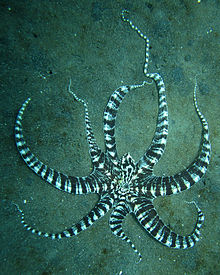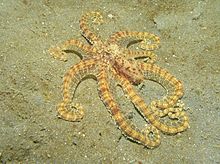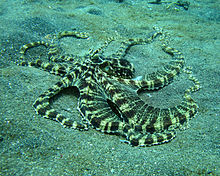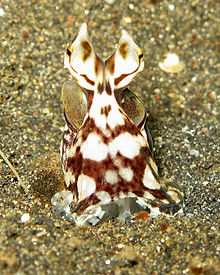- Mimic Octopus
-
Mimic Octopus 
Scientific classification Kingdom: Animalia Phylum: Mollusca Class: Cephalopoda Order: Octopoda Family: Octopodidae Subfamily: Octopodinae Genus: Thaumoctopus
Norman & Hochberg, 2005Species: T. mimicus Binomial name Thaumoctopus mimicus
Norman & Hochberg, 2005The Mimic Octopus, Thaumoctopus mimicus, is a species of octopus that has a strong ability to mimic other creatures. It grows up to 60 cm (2 feet) in length. Its normal colouring consists of brown and white stripes or spots.
Living in the tropical seas of South East Asia, it was not discovered officially until 1998, off the coast of Sulawesi. The octopus mimics the physical likeness and movements of more than fifteen different species, including sea snakes, lionfish, flatfish, brittle stars, giant crabs, sea shells, stingrays, flounders, jellyfish, sea anemones, and mantis shrimp.[1][2] It accomplishes this by contorting its body and arms, and changing colour.
Although all octopuses can change colour and texture, and many can blend with the sea floor, appearing as rocks, the mimic octopus is the first octopus species ever observed to impersonate other animals.[2][3]
Based on observation, the mimic octopus may decide which animal to impersonate depending on local predators. For example, when the octopus was being attacked by damselfish, it was observed that the octopus appeared as a banded sea snake, a damselfish predator. The octopus impersonates the snake by turning black and yellow, burying six of its arms, and waving its other two arms in opposite directions.[4]
The mimic octopus is often confused with Wunderpus photogenicus, another recently discovered species.[5] Wunderpus can be distinguished by the pattern of strong, fixed white markings on its body.[6]
Contents
Habitat and behavior
Mimic octopuses have been known to live exclusively in nutrient-rich estuarine bays of Indonesia and Malaysia full of potential prey. They use a jet of water through their funnel to glide over the sand while searching for prey, typically small fish, crabs, and worms. Mimics are also prey themselves. Like other octopuses, their soft bodies are made of nutritious muscle, without spine or armor, and not obviously poisonous, making them desirable prey for large deep water carnivores, such as barracuda and small sharks. Often unable to escape such predators, its mimicry of different poisonous creatures serves as its best defense. Mimicry also serves to allow it to prey upon animals that would ordinarily flee an octopus; it can imitate a crab as an apparent mate, only to devour its deceived "suitor".
This octopus mimics venomous sole, lion fish, sea snakes, sea anemones, and jellyfish. For example, the mimic is able to imitate a sole by pulling its arms in, flattening to a leaf-like shape, and increasing speed using a jet-like propulsion that resembles a sole. When spreading its legs and lingering on the ocean bottom, its arms trail behind to simulate the lion fish's fins. By raising all of its arms above its head with each arm bent in a curved zig-zag shape to resemble the lethal tentacles of a fish-eating sea anemone, it deters many fish. It imitates a large jellyfish by swimming to the surface and then slowly sinking with its arms spread evenly around its body.
Unlike the vast majority of octopuses, it regularly traverses tunnels and burrows in the sea floor to search for food and to conceal itself from predators. It can often be seen surveying its surroundings from one of these burrows, with only its eyes and head sticking out of the hole.[7]
Feeding
The Mimic Octopus often feeds by covering an area of sand under a disc of webs while using the tips of its fine arms to flush small animals into its suckers. It can probe its arms deep into burrows or holes to search for prey which it can then pass to its mouth.
References
- ^ AdvancedAquarist.com's article Captive Observations of the Mimic Octopus
- ^ a b PBS.org's article Legend of the deep
- ^ MarineBio.org's article Thaumoctopus mimicus Mimic Octopus
- ^ NationalGeographic.com's 2001 news article Newfound Octopus Impersonates Fish, Snakes
- ^ Hochberg, F.G., M.D. Norman & J. Finn 2006. Wunderpus photogenicus n. gen. and sp., a new octopus from the shallow waters of the Indo-Malayan Archipelago (Cephalopoda: Octopodidae).PDF (805 KiB) Molluscan Research 26(3): 128–140.
- ^ Norman, Mark (2000). Cephalopods: A World Guide. Hackenheim, Germany: ConchBooks. pp. 302–304. ISBN 3-925919-32-5.
- ^ Piper, Ross (2007), Extraordinary Animals: An Encyclopedia of Curious and Unusual Animals, Greenwood Press.
- Butvill, David B. The Changeling. "Current Science" October 7, 2005
- Norman, Mark. Dynamic mimicry in an Indo-Malayan octopus. The Royal Society 2001
- Norman, Mark. Masters of Mimicry. "Nature Australia" Spring 2002, vol 27, Issue 6, p38
External links
- Captive Observations of the Mimic Octopus, Thaumoctopus mimicus
- TONMO.com Octopodidae Forum - includes mimic octopus discussions
- National Geographic.com Article
- Starfish with photos of the mimic octopus
- Island Dream's photo
- Norman, Mark D.; Finn, Julian; Tregenza, Tom (2001): Dynamic mimicry in an Indo-Malayan octopus. Proceedings of the Royal Society, 268, p. 1755–1758 2001 paper describing the discovery (PDF)
- Norman, Mark D. & Hochberg, F. G. (2005): The "Mimic Octopus" (Thaumoctopus mimicus n. gen. et sp.), a new octopus from the tropical Indo-West Pacific (Cephalopoda: Octopodidae). Scientific description (Abstract)
- PZ Myers (29 November 2004). "Indo-Malayan mimic octopus". Pharyngula. Archived from the original on 2008-09-16. http://web.archive.org/web/20080916222939/http://pharyngula.org/index/weblog/comments/indo_malayan_mimic_octopus/.
Categories:- Octopodidae
- Animals that can change color
Wikimedia Foundation. 2010.



